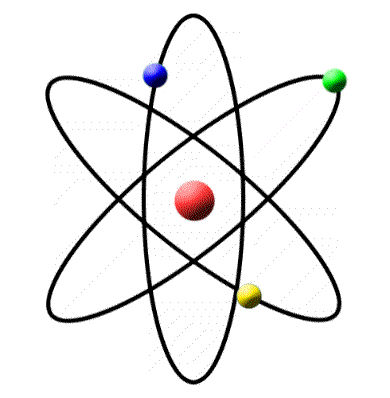A proton and an $\alpha$-particle are simultaneously projected in opposite directions into a region of uniform magnetic field of $2\, mT$ perpendicular to the direction of the field. After some time it is found that the velocity of proton has changed in direction by $90^{\circ}$. Then at this tune, the angle between the velocity vectors of proton and $\alpha$ - particle is
- $60^{\circ}$
- $90^{\circ}$
- $45^{\circ}$
- $180^{\circ}$
The Correct Option is C
Solution and Explanation
Top Questions on Atoms
- Apart from the acoustic modes, 9 optical modes are identified from the measurements of phonon dispersions of a solid with the chemical formula \( A_nB_m \), where \( A \) and \( B \) denote the atomic species, and \( n \) and \( m \) are integers. Which of the following combinations of \( n \) and \( m \) is/are possible?
- The non-relativistic Hamiltonian for a single electron atom is
\[ H_0 = \frac{p^2}{2m} - V(r) \]
where \( V(r) \) is the Coulomb potential and \( m \) is the mass of the electron.Considering the spin-orbit interaction term:
\[ H' = \frac{1}{2m^2c^2} \frac{1}{r} \frac{dV}{dr} \overrightarrow{L} \cdot \overrightarrow{S} \]
added to \( H_0 \), which of the following statements is/are true? - An atom is subjected to a weak uniform magnetic field \( B \). The number of lines in its Zeeman spectrum for the transition from \( n = 2, l = 1 \) to \( n = 1, l = 0 \) is
- Hydrogen atom from excited state comes to the ground by emitting a photon of wavelength $\lambda$ The value of principal quantum number 'n' of the excited state will be :(R : Rydberg constant)
- The energy levels of an atom is shown in figure:

Which one of these transitions will result in the emission of a photon of wavelength $1241\, nm$ ? Given $\left( h =6.62 \times 10^{-34} Js \right)$
Questions Asked in AP ECET exam
- Let $M$ and $m$ respectively denote the maximum and the minimum values of $[f(\theta)]^{2}$, where $f(\theta)=\sqrt{a^{2} \cos ^{2} \theta+b^{2} \sin ^{2} \theta}$ $+\sqrt{a^{2} \sin ^{2} \theta+b^{2} \cos ^{2} \theta}$. Then $M-m=$
- AP ECET - 2019
- Application of derivatives
- The half-life periods of a first order reaction at $300\, K$ and $400\, K$ are $50\, s$ and $10\, s$ respectively. The activation energy of the reaction in $kJ \; mol^{-1}$ is (log 5 = 0.70)
- AP ECET - 2019
- Chemical Kinetics
- If $I_{n} = \int \frac{\sin nx}{\sin x} dx $ for $n = 1, 2 , 3,...,$ then $I_6$ =
- AP ECET - 2019
- integral
- A solution is prepared by dissolving $10 \,g$ of a non-volatile solute (molar mass, $'M^{\prime} g mol ^{-1}$ ) in $360\, g$ of water. What is the molar mass in $g\, mol ^{-1}$ of solute if the relative lowering of vapour pressure of solution is $5 \times 10^{-3}$ ?
- AP ECET - 2019
- Solutions
- A solid copper sphere of density $\rho$, specific heat capacity $C$ and radius $r$ is initially at $200\, K$. It is suspended inside a chamber whose walls are at $0\, K$. The time required (in (is) for the temperature of the sphere to drop to $100 \,K$ is ($\sigma$ is Stefan's constant and all the quantities are in SI units)
- AP ECET - 2019
- radiation
Concepts Used:
Atoms
- The smallest unit of matter indivisible by chemical means is known as an atom.
- The fundamental building block of a chemical element.
- The smallest possible unit of an element that still has all the chemical properties of that element.
- An atom is consisting of a nucleus surrounded by one or more shells of electrons.
- Word origin: from the Greek word atomos, which means uncuttable, something that cannot be divided further.
All matter we encounter in everyday life consists of smallest units called atoms – the air we breath consists of a wildly careening crowd of little groups of atoms, my computer’s keyboard of a tangle of atom chains, the metal surface it rests on is a crystal lattice of atoms. All the variety of matter consists of less than hundred species of atoms (in other words: less than a hundred different chemical elements).

Every atom consists of an nucleus surrounded by a cloud of electrons. Nearly all of the atom’s mass is concentrated in its nucleus, while the structure of the electron cloud determines how the atom can bind to other atoms (in other words: its chemical properties). Every chemical element can be defined via a characteristic number of protons in its nucleus. Atoms that have lost some of their usual number of electrons are called ions. Atoms are extremely small (typical diameters are in the region of tenths of a billionth of a metre = 10-10 metres), and to describe their properties and behaviour, one has to resort to quantum theory.



